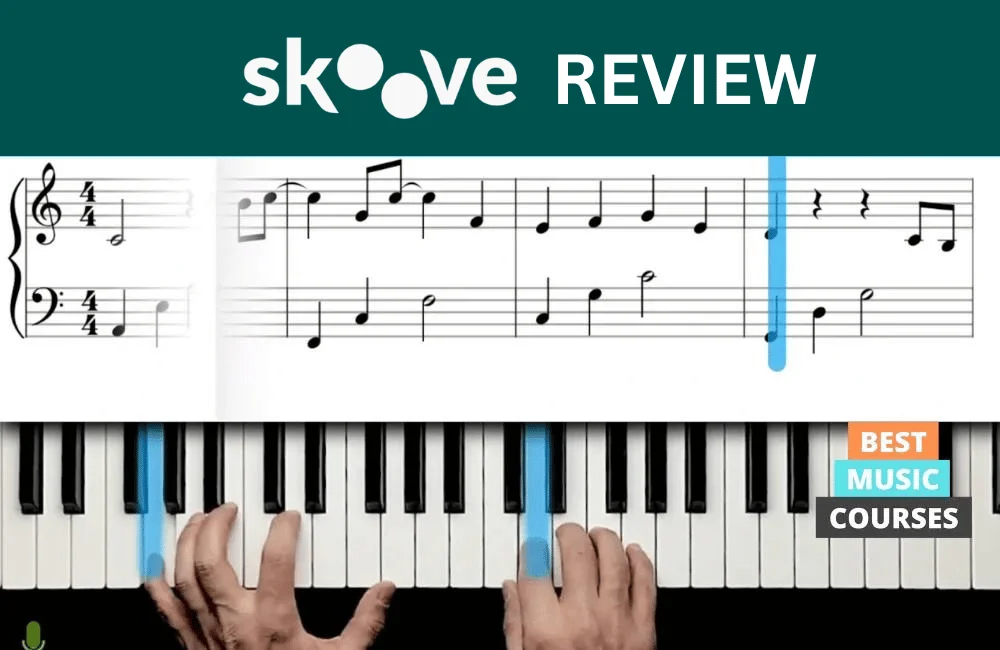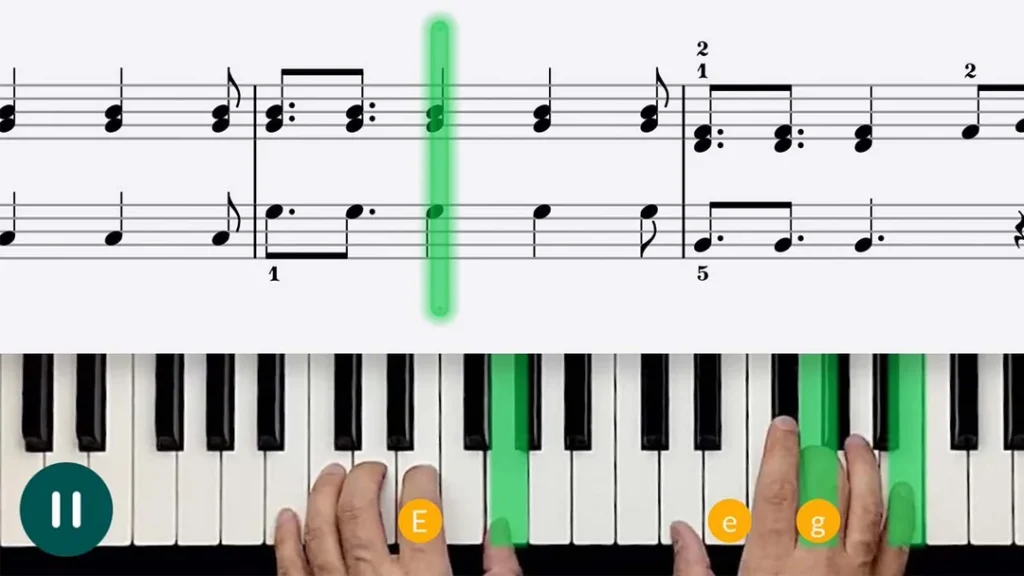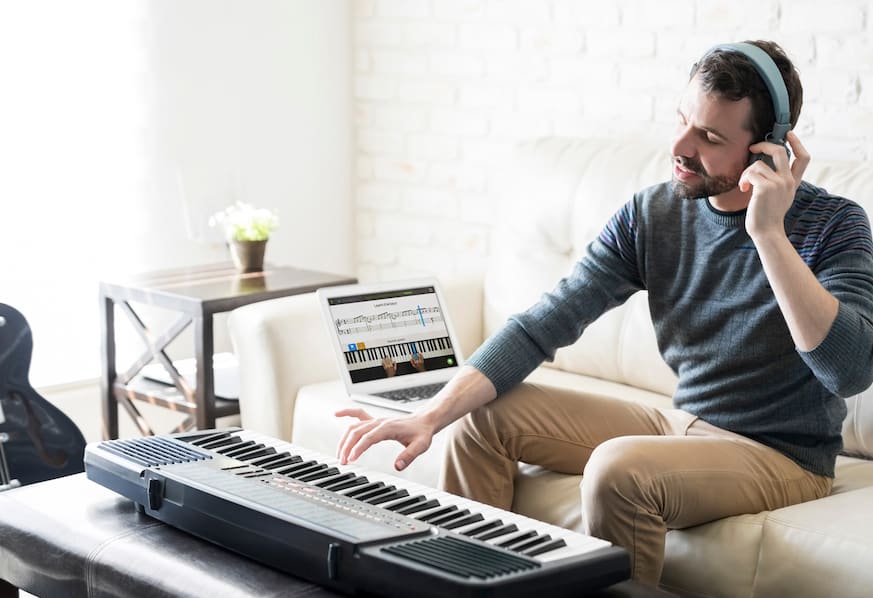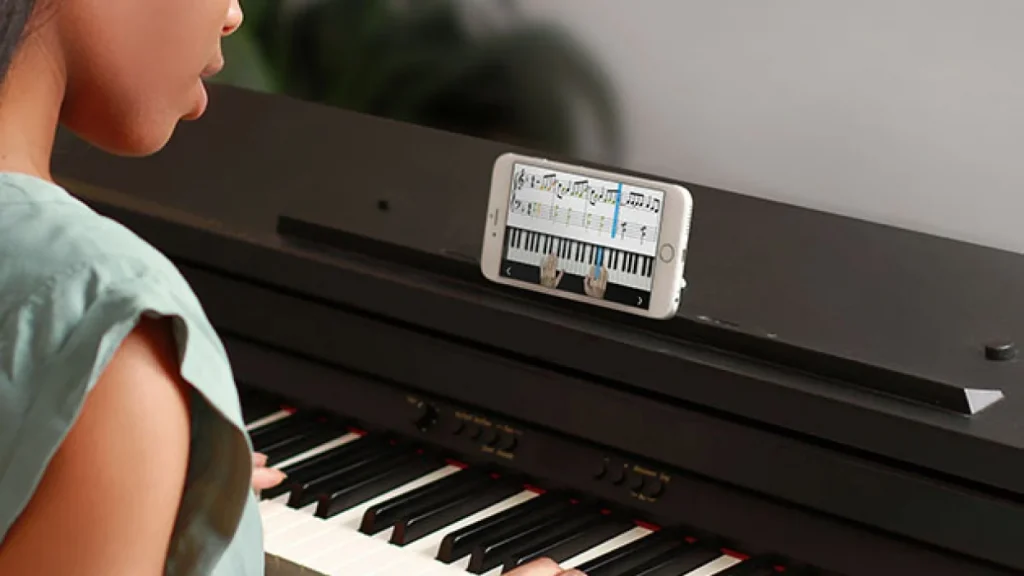The piano stands as a central pillar in the musical traditions of countless cultures worldwide, with millions honing some degree of mastery over the instrument.
Skoove has rapidly ascended as one of the most favored platforms for learning piano online, owing to its reputation for swiftly guiding students through the basics. However, does it truly deliver on its promise?
I’ve dedicated time to delving into what Skoove has to offer and have experimented with various other music-learning platforms as well. This comparative exploration has provided me with ample insights to reflect upon and convey.
In this review, I’ll break down the essential information you need, alongside my personal experiences and viewpoints on the platform.
Let’s begin, shall we?
If you’re pressed for time, here are the key takeaways:
Quick Overview
What you’ll learn:
- The foundational elements of piano, including sight-reading, melody creation, and the coordination of both hands.
- A range of songs designed to reinforce newly acquired techniques.
- Core classical and contemporary pieces, from Beethoven’s compositions to The Beatles’ hits.
- Techniques for constructing chords and scales.
- Introduction to new key signatures and their application in modern pop music.
- The energetic boogie-woogie piano style.
Advantages
- Vibrant visuals that accelerate your learning curve.
- Flexible pacing allows you to learn at your own speed, anywhere, anytime.
- Extensive content catering to various skill levels.
- A combination of technique and song practice, offering a holistic approach to learning.
- Handy tools like note recognition to aid in mastering challenging sections.
Drawbacks
- Occasionally lacks depth in certain areas.
- Course material may feel familiar to users of other platforms.
- Absence of interaction or personalized feedback from instructors.
Course Length: As flexible as you need it to be. With a Premium subscription, there are no restrictions on the number of courses you can undertake. Each lesson’s duration is dependent on how quickly you grasp the song or exercise, and how frequently you wish to practice. After completing each lesson, Skoove provides feedback on your total practice time.
Ideal for: Individuals seeking to learn popular piano tunes swiftly, especially those wanting to refine a particular skill or technique concurrently. This intersection of learning songs and techniques is arguably Skoove’s strongest selling point. While it’s primarily geared towards beginners, there’s content available for learners at all stages of their musical journey.
Conclusion: Skoove effectively fulfills its purpose. Its combination of intuitive tools and engaging visuals will enhance your skills, while continually expanding your musical repertoire. Although other platforms may delve deeper into similar concepts, if Skoove’s approach resonates with you, it’s a strong choice for embarking on your piano-learning adventure. And the best part? You can start for free today!
Skoove Review: An In-Depth Look
In this Skoove review, I’ll be covering:
- Everything about Skoove
- My personal take on the Skoove courses
- The platform’s standout features
- Areas where I think there’s room for improvement
- Who I believe this platform is best suited for
- The costs involved and possible alternatives
- And the burning question: Is Skoove worth it?
So, let’s dive right in!
Skoove originates from Germany, with its original team establishing and developing the platform as early as 2014. Since then, it has rapidly evolved into one of the most widely utilized methods for learning piano online.
With options for both piano and guitar, Skoove can be accessed on a variety of devices: tablets, iPhones, and laptops. Today, the platform boasts a user base exceeding one million.
The current Skoove team consists of around twenty passionate music enthusiasts.
Combining cutting-edge technology with deep musical knowledge, Skoove’s mission is clear: to help you master the piano.
Getting Started with Skoove
The first step on your Skoove journey is to sign up and create an account. You can instantly access lessons catering to different skill levels for free. Additionally, there’s a free trial option that gives you a glimpse of the premium features without needing to pay upfront.
Premium membership unlocks the full spectrum of what Skoove has to offer. This includes a wide variety of songs, techniques, practice exercises, and new musical concepts.
One of the great advantages is that there are no limitations on how many lessons you can take, nor is there a rigid course sequence. By simply clicking on the course icon, you’re taken to a page where you can pick and choose whatever catches your attention.
Once you select a course, you’ll be shown the available lessons. Again, you can complete them in any order you like. Some courses, such as Beginner 1, introduce new musical concepts and then allow you to apply them by learning a new song.
Other courses, like the Queen Songs course, are more song-centric.
Among the fan-favorites available for learning, you’ll find:
- We Will Rock You
- The Scientist
- Piano Man
- Back To Black
- Rolling In The Deep
- Let It Be
Before diving into the lessons, Skoove will ask if you have access to a piano or if you’d prefer to use your device’s keypad. Naturally, using a real piano is recommended for the best experience.
Click Here To Visit Skoove
Learning Process on Skoove
The learning process typically begins with an explanation of a new concept or technique, followed by a playthrough that demonstrates what it should sound like—often through a song example.
After that, it’s your turn. You can practice the song or exercise, using Skoove’s note recognition technology, either on your keyboard or via your device. You can repeat this as many times as needed, and the exercise will only proceed once you hit the correct note.
Afterward, you’ll practice alongside a backing track. Once completed, Skoove provides feedback on how much time you’ve spent practicing, allowing you to decide when to move on.
This method allows for a smooth and intuitive learning experience that combines theory and practice in a natural progression.
My Review of the Skoove Courses
To compile this review, I’ve worked through lessons from the beginner, intermediate, and advanced sections of Skoove. These levels form the foundation of my course evaluation below. While Skoove offers other specialized courses, these are more niche and tailored to learners with very specific goals in mind.
Beginner
Platforms like Skoove often focus on attracting beginners, so it makes sense to start here.
One of the standout features for beginners is the opportunity to become familiar with the platform’s interface. Mastering this early on makes transitioning to the intermediate lessons smoother, especially if you approach them with confidence.
Even though I’m not a complete beginner, I was impressed by how Skoove introduces the piano. Of the three skill levels, this beginner section is probably the most well-executed.
I can confidently say that if I were starting piano for the first time, I’d be thrilled with my progress.
You will learn:
- How to number your fingers and where to position them on the keys
- The basics of playing with both hands simultaneously
- Understanding note lengths and values
- Learning the names of the keys and the foundations of sight-reading
- Grasping intervals between notes
- A variety of beginner-friendly songs, from “Lean On Me” to “Angels,” which incorporate all these concepts
Pros:
- You learn pieces and core musical concepts side by side
- A wide selection of songs tailored for beginners
- A rare opportunity to develop musicality with a backing track
- Covers all the essential elements of playing piano
- Note recognition technology ensures you only move forward once you’ve mastered the current concept
- Visual aids help you develop sight-reading skills early on
Cons:
- Lacks the personal touch of a teacher who can guide you through the process
- Playing on a computer keypad isn’t the best way to dive into piano learning
Course Length: Skoove offers three beginner courses, each containing about 10-20 lessons. The length of each lesson depends on how quickly you grasp the material and how much time you spend practicing. After completing a song with a backing track, Skoove will show your practice duration.
Best for: Complete novices. You don’t need any prior experience. While encountering sheet music in the first lesson may feel intimidating, the interface is highly intuitive, and you’ll be surprised by how fast you progress.
Overall: Skoove truly shines when it comes to teaching beginners. The note recognition technology helps you quickly adapt, learning where to place your fingers and understanding the instrument. It’s incredibly satisfying to see everything come together in a piece of music. By breaking down complex musical concepts into manageable chunks, Skoove ensures that learning feels achievable. The sheer volume of songs available to beginners is also a fantastic motivator, keeping you engaged throughout your learning journey.
Intermediate: A Deeper Dive into Skoove
After completing the three beginner courses, you’re ready to move into the intermediate realm. From my experience, this is often the trickiest group to satisfy.
The challenge lies in the diversity of the learners. You could have just ten lessons under your belt or a decade of playing experience and still consider yourself an intermediate—it really depends on perspective.
That being said, there’s still an abundance of knowledge to acquire, and plenty of songs to help you along the way.
As a longtime fan of spy films, I was delighted to learn the James Bond theme during these lessons—it transported me straight back to my childhood. So, I’ll admit, I was already hooked from the start.
You will learn:
- The use of flats and sharps
- How to divide the responsibilities between your right and left hand
- New key signatures and corresponding songs to apply them
- Building and understanding major and minor chords
- Some Coldplay classics (because let’s be honest, there’s at least one you love)
- Major and minor scales, taught through songs like Piano Man and Mad World
- The structure of diminished and broken chords
Pros:
- You can move through the material at your own pace
- The lessons build naturally on the beginner courses, ensuring a smooth transition
- An even wider selection of songs, challenging your abilities while keeping things fun
- The theory taught applies to all forms of music, not just piano
- Exposure to a broader range of musical genres
Cons:
- Could benefit from more in-depth theory lessons, such as intervals and the circle of fifths
- The absence of a teacher might make more technical concepts harder to grasp
- Some lessons might feel too elementary for those at the higher end of the intermediate spectrum
Course Length: Similar to the beginner courses, there are three intermediate levels in Skoove, each with 10-20 lessons. How long it takes to complete them is entirely up to you. Given your growing familiarity with the piano at this point, these lessons will likely take less time than the beginner ones.
Best for: Primarily aimed at learners who are just stepping into the intermediate zone from the beginner level. Many will already know their major scales and broken chords. Beginners who’ve breezed through the first levels and are eager to advance will likely feel most comfortable here.
Overall: Learning without a teacher makes Skoove a great fit for intermediate players, offering a level of freedom that allows you to explore at your own pace. You’ll likely feel confident enough to tackle these lessons solo, while still benefiting from Skoove’s structured tools. Some lessons may be on the lighter side in terms of difficulty, and there’s room for more music theory, but the extensive song list will keep most learners enthusiastic as they build their repertoire.
Advanced: A Look at Skoove for Seasoned Pianists
Advanced players typically don’t begin their musical journey with online platforms. However, Skoove does offer some valuable content for those at this level.
Since I’m not an advanced pianist myself, it’s a bit more challenging for me to assess this group fully. However, the excitement of tackling Beethoven in my first advanced lesson certainly made me feel like a maestro, even if it took a few tries to nail it.
You will learn:
- Mastering tonic and dominant notes
- Advanced techniques like parallel playing and refining your technique
- Complex musical theory, including arpeggios and cadences
- Understanding power chords and chord symbols
- Mastery of chord inversions
- Exploring legendary pop songs alongside the theory that makes them shine
Pros:
- Equal focus on both classical and pop genres, offering versatility
- A robust repertoire in both styles, providing variety
- Music theory concepts that are applicable beyond just piano
- A natural progression from the intermediate courses
- Well-paced introduction of new and advanced ideas
Cons:
- Lacks detailed explanations in some areas
- Some tools become less effective at this skill level
- Likely beneath the abilities of some advanced players
Course Length: At the advanced level, Skoove offers two courses—advanced classical and advanced pop. The classical course includes 15 lessons, while the pop course features 23 lessons.
Best for: This course is ideal for pianists who have progressed through the Skoove intermediate levels and want to challenge themselves further. Advanced learners who struggle with sight-reading will find Skoove’s visual aids helpful, as will those seeking sheet music for popular songs.
Overall: Advanced learners are notoriously difficult to satisfy. What can you teach to pianists who already know so much? I think they’d appreciate the diverse song selection here, and I’m impressed by the balance between classical and pop. However, I can’t shake the feeling that much of the content might be too elementary for those who are truly advanced. Perhaps calling this course “Intermediate II” would be more fitting.
Other Skoove Courses
Once you’ve completed the beginner, intermediate, and advanced levels, you can dive into more specialized courses, such as:
- Blues and Boogie Woogie
- Chords and Scales
- Keyboard for Producers
- The Beatles Songs
- Queen Songs
- Soundtracks
- Christmas Songs
These courses offer an excellent way to hone specific skills and expand your repertoire across different musical styles.
What I Liked About Skoove
Learn Songs and Techniques Simultaneously
One of the standout features of Skoove, in my opinion, is how they teach new musical concepts through popular songs. This method makes learning both engaging and efficient. As someone who has some experience with the piano but started with the beginner lessons for review purposes, I can say that if I were a total novice, I would have been thrilled with my progress from the very first lesson.
Not only do you learn a new musical technique, but you also quickly pick up a song, which can be a huge confidence boost.
Different people have different motivations when learning music, but for most, the ultimate goal is to perform songs and perform them well. The technical exercises, ear training, and sight-reading practices are all part of a bigger picture: developing musicality for more challenging pieces. Skoove’s approach of combining song lessons with technique instruction hits that sweet spot. Learners build their repertoire while enhancing their understanding of the instrument.
It’s an incredibly effective teaching method, combining the joy of playing real music with the benefits of solid technical foundation.
Strong Visuals
The piano can seem intimidating, especially for beginners who may be overwhelmed by its complexity. The visuals provided by Skoove make the learning process much more approachable.
The split-screen feature, which shows both sheet music and a keyboard, helps beginners bridge the gap between music notation and the piano keys, a common obstacle for first-time players.
Skoove highlights the section of the music you’re supposed to play, so your eyes know exactly where to focus, and the notes on the keyboard are clearly numbered, aiding in finger placement. This setup makes finger dexterity and sight-reading feel natural as you progress through lessons.
Additionally, a small progress tab at the top of the screen shows how far you’ve come in the lesson and how much is left. This small touch kept me motivated, especially when tackling the more challenging advanced lessons.
Individually, these features may seem minor, but together, they create a visually intuitive and effective learning environment that simplifies the complexities of the piano.
Effective Tools
Alongside the visuals, Skoove offers a set of powerful online tools that aid the learning process. One tool that stood out to me was the note recognition technology.
Many people argue that online learning can’t replicate the in-person experience of traditional lessons. While I think the effectiveness of learning depends largely on the student and teacher, e-learning platforms like Skoove introduce innovative features that are unique to online education.
The note recognition tool is particularly impressive. It listens to the notes you play on your keyboard and lets you know if you hit them correctly or not, ensuring you can only move forward once you’ve played the correct note. This system takes the trial-and-error process of learning and accelerates it, making it much easier to overcome tricky passages quickly.
Plus, after your solo practice, you get to play along with a backing track, which makes you feel like a professional in no time.
Impressive Song Bank
Skoove’s song library is extensive and diverse, covering a wide range of genres, styles, and artists. Whether you’re into classical music or modern pop, there’s something for everyone.
I was particularly impressed with the range of songs available, from classical pieces to hits by The Beatles. For those who want to build a varied repertoire, this is a huge plus.
Learn at Your Own Pace
One of the biggest advantages of Skoove is the flexibility it offers. You can log in whenever you want and spend as much or as little time on a lesson as you need. There are no strict schedules or limits, allowing you to progress entirely at your own pace.
While you do need to play each song correctly at least once to move forward, you can always repeat lessons or practice songs as many times as necessary. This freedom makes learning less stressful and more aligned with individual learning styles.
Moreover, for beginners, you don’t even need a piano to start. Skoove offers the option to use your computer keyboard for the initial lessons. Although it’s not a perfect substitute for a real piano, it gives beginners a chance to try out the platform before committing to buying an instrument.
Conclusion
Overall, Skoove embraces the flexibility of online learning, allowing students to set their own pace and direction. It’s an innovative and adaptive way to learn the piano, combining traditional musical concepts with modern technology. While there are downsides, which I’ll cover in the next section, I found the experience of learning at my own pace under my own direction both enjoyable and effective. Skoove is certainly taking advantage of the changing landscape of education and music learning in the digital age.
Who Is Skoove For?
If you’re interested in learning piano, Skoove is designed with you in mind. With a dedicated team passionate about the piano, Skoove naturally appeals to anyone curious about the instrument, from complete beginners to more experienced players.
However, I believe specific groups will benefit most from using Skoove:
- Learners who want to combine songs and techniques in each lesson: Skoove’s teaching method of incorporating popular songs into technical lessons is perfect for those who want to develop musical skills while building a repertoire.
- Intermediate players seeking a curated song library: For those with some piano experience looking to expand their song selection, Skoove’s extensive song bank offers plenty of options to explore.
- Players looking to specialize in genres: With courses dedicated to classical music, boogie-woogie, and more, Skoove is ideal for pianists aiming to hone their skills in specific styles.
- Beginners who want to learn quickly: Skoove’s user-friendly interface and structured lessons are tailored to help beginners make progress fast, even if they have no prior experience with the piano.
- People without immediate access to a piano: If you don’t own a piano, Skoove offers the option to start learning using a computer keyboard, allowing you to test out the platform before investing in an instrument.
- Music producers: Skoove offers a Keyboard For Producers course, making it a great fit for producers wanting to improve their piano skills and deepen their understanding of musical foundations.
Who Skoove Might Not Be Best For
If your goal is to develop a comprehensive understanding of music theory outside of just the piano, you might find that Skoove doesn’t dive deeply enough into these concepts. Other platforms that focus more on theory might suit you better.
That said, Skoove still provides a valuable learning experience if it feels like a good fit for your goals. Just keep in mind what you’re hoping to get out of it before making your decision.
How Much Does Skoove Cost?
Skoove offers a range of pricing options depending on your commitment and budget.
- Free Option: You can access a limited number of lessons across the beginner, intermediate, and advanced levels for free. There’s also a 7-day free trial that unlocks all premium features, allowing you to explore the full range of lessons and tools without charge for one week.
- Premium Subscription Options:
- 1-Month Package: $9.99 per month, which provides full access to the entire platform.
- 3-Month Package: Billed at $13.33 per month (total: $39.99), giving you the same full access.
- 1-Month Premium Package: $24.75 for a single month of premium access, ideal for those who want everything unlocked but only for a short period.
Each option grants you access to all lessons, tools, and songs available on the platform during the subscription period.
Is Skoove Worth It?
If you’re still reading, you’re probably wondering: Is Skoove worth the investment?
My answer, as always, is nuanced.
Skoove is a strong contender in the crowded field of online piano education, but whether it’s the right choice depends on what you’re seeking.
Pros:
- For Quick Learners: If you’re looking to swiftly learn popular songs and develop basic piano skills in a fun and interactive way, Skoove shines. Its combination of visual aids and integrated song practice offers an engaging learning experience.
- Flexible Learning: You can progress at your own pace, with the ability to track your practice time and revisit lessons as needed. This personalized approach is beneficial for those who enjoy learning on their own schedule.
- Innovative Features: The use of note recognition technology and visually intuitive lessons makes it easier for beginners to grasp concepts and improve their sight-reading skills.
Cons:
- Lack of Depth: Skoove may not satisfy those who wish to dive deeply into advanced music theory, ear training, or performance techniques. For a more comprehensive theoretical foundation, you might need to supplement with other resources.
- Absence of Personal Interaction: The platform lacks the personal touch of a live teacher, which can be crucial for some learners. If developing a mentor-student relationship is important to you, Skoove might fall short.
In summary, if your goal is to enjoy learning popular tunes and build a solid foundation in a flexible, engaging manner, Skoove is definitely worth considering. However, if you aim to delve deeply into complex music theory or require personal guidance, you might want to explore additional resources. With the free trial available, you can test it out to see if it aligns with your learning style before committing.
Frequently Asked Questions
How much does Skoove cost?
Skoove offers lessons for free, but for full access, you’ll need a premium subscription. The cost for a 12-month premium plan is $9.99 per month, while the 3-month plan is priced at $13.33 per month. Both plans provide the same content, though the annual plan is more popular.
Does Skoove have a refund policy?
Yes, Skoove offers a refund policy. If you’re not satisfied with the service, you can request a refund within 14 days by contacting their support team via email or postal mail, details of which can be found on their website.
How many courses are there on Skoove?
Skoove is continually updating and expanding its offerings. As of now, a premium subscription provides access to approximately 400 lessons and a wide range of songs across about 21 courses. The number of courses and lessons is expected to grow.
Does Skoove have a free trial?
Yes, Skoove offers a 7-day free trial of its premium features, allowing you to explore all the content before committing to a subscription.














Leave a Comment